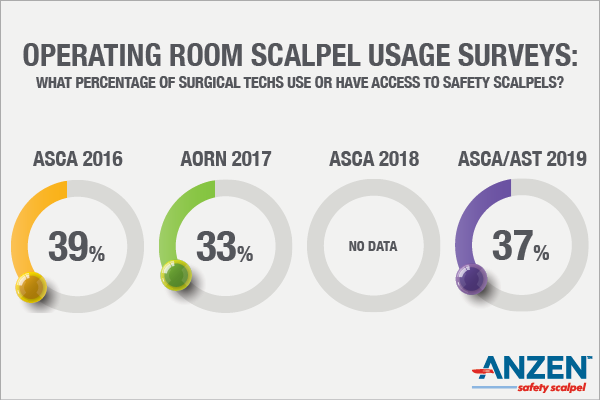Dissecting Safety Scalpel Trends 2016–2019, Part 1: Surveying Surgical Technologists
August 1, 2019Surgical Techs say scalpel-related injuries in the OR remain high, yet despite high awareness of safety scalpels, usage remains low. Why are scalpels with sharps safety features still not a standard…and what is MediPurpose doing to change that?
Our soon-to-be-launched Anzen safety scalpel will be entering a rather challenging market. We know that many surgeons prefer to use traditional scalpels in the operating room instead of scalpels with sharps safety features — despite a high frequency of scalpel-related injuries to themselves, surgical technologists and patients.
We’ve been aware of the prevailing resistance to safety scalpels ever since we first started developing Anzen in the early 2010s. However, with more than 20 years of experience with developing and manufacturing safety medical devices, we are confident that if we create an ideal safety scalpel that performs as well as a traditional scalpel, it could become the standard for reducing avoidable scalpel injuries in the OR.
What is an Ideal Safety Scalpel? We Know Because We’ve Been Listening to Surgical Technologists for Years
All MediPurpose medical devices are created with research and design (R&D) processes that prioritize end-users’ input throughout the entire “concept to commercialization” journey. This is how we first determine what end-users need from an “ideal” medical device, as well as how we validate that what we produce actually meets their expectations. We therefore frequently use surveys and product evaluations to collect both quantitative and qualitative data to help us create and refine everything from prototypes to packaging to training materials.
For safety scalpels, “end users” means surgeons and surgical techs. Although these two groups of users work together in the OR, we analyze their input as two different sets of data. This blog will share some of the insights we’ve gained from the perspectives of surgical techs; a second blog will focus on surgeons’ safety scalpel perspectives.
We surveyed surgical techs during the past several years at events hosted by AORN (Association of periOperative Registered Nurses), ASCA (Ambulatory Surgery Center Association) and AST (Association of Surgical Technologists. Since 2016, we’ve queried approximately 630 surgical techs about three key concepts that are helping us more fully understand their needs and expectations, including:
- Their experiences with scalpel injuries (either as a victim or a witness)
- Their awareness of safety sharps devices (with safety scalpels in particular)
- The availability and usage of safety scalpels in their operating rooms
…little has changed with their viewpoints about safety scalpel experiences, awareness and usage.
Most recently, we exhibited at ASCA 2019 (Ambulatory Surgery Center Association) and AST 2019 (Association of Surgical Technologists) and surveyed approximately 100 surgical techs. The results indicate that little has changed with their viewpoints about safety scalpel experiences, awareness and usage.
Experience with Scalpel Injuries: A Problem That’s Not Going Away
We asked surgical techs questions that were designed to help us better understand the frequency for which they’ve witnessed or suffered from a scalpel injury in the operating room.

Although the rates rose and fell between 2016 and 2019, what remains constant is that a majority of surgical techs reported being parties to scalpel injuries. This fact makes the results from the next two series of questions even more intriguing.
Awareness of Safety Scalpels: Rates Stay Flat
Next, we’ve asked surgical techs questions that were designed to help us better understand their awareness of safety scalpels as alternatives to traditional scalpels and their sharps safety indications.

There was little change in rates between 2017 and 2019 and surgical techs’ safety scalpel awareness rates remained very high.
Usage of Safety Scalpels: Rates Also Stay Flat
Finally, we’ve asked surgical techs questions that were designed to help us better understand their usage of safety scalpels in the OR (which included availability).

There was again little change in rates between 2017 and 2019 and surgical techs’ safety scalpel usage rates unfortunately remained very low.
Final Analysis: We Must Continue to Understand and Meet the Needs of OR Workers to Increase Safety Scalpel Usage Rates
There’s no shortage of data to indicate that operating rooms have a distinct problem (scalpel-related injuries) but also have a viable solution (safety scalpels). It doesn’t take a deep dive into the data to appreciate there clearly is a disconnect that is hindering an increase in safety scalpel usage. So then, why is there this disconnect, and what can be done to correct it?
There are many reasons for the disconnect—and we’ll touch on them in our next blog that examines surgeons’ safety scalpel perspectives (which have been a crucial factor in the low adoption of safety scalpels). As far as what can be done, we’re continuing to close the gap for users’ unmet expectations for an ideal safety scalpel solution!
If you would like to learn more about evaluating Anzen™ safety scalpels at your facility, please contact us and/or request samples.


